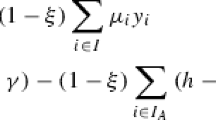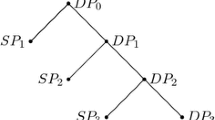Abstract
We present an interior-point branch-and-cut algorithm for structured integer programs based on Benders decomposition and the analytic center cutting plane method (ACCPM). We show that the ACCPM based Benders cuts are both pareto-optimal and valid for any node of the branch-and-bound tree. The valid cuts are added to a pool of cuts that is used to warm-start the solution of the nodes after branching. The algorithm is tested on two classes of problems: the capacitated facility location problem and the multicommodity capacitated fixed charge network design problem. For the capacitated facility location problem, the proposed approach was on average 2.5 times faster than Benders-branch-and-cut and 11 times faster than classical Benders decomposition. For the multicommodity capacitated fixed charge network design problem, the proposed approach was 4 times faster than Benders-branch-and-cut while classical Benders decomposition failed to solve the majority of the tested instances.
Similar content being viewed by others
References
Bahn, O., du Merle, O., Goffin, J.-L., & Vial, J.-P. (1995). A cutting plane method from analytic centers for stochastic programming. Mathematical Programming, 69(1), 45–73.
Barnhart, C., Johnson, E. L., Nemhauser, G. L., Savelsbergh, M. W. P., & Vance, P. H. (1998). Branch-and-price: column generation for solving huge integer programs. Operations Research, 46, 316–329.
Benders, J. (1962). Partitioning procedures for solving mixed-variables programming problems. Numerische Mathematik, 4, 238–252.
Costa, A. M. (2005). A survey on Benders decomposition applied to fixed-charge network design problems. Computers and Operations Research, 32(6), 1429–1450.
Cote, G., & Laughton, M. (1984). Large-scale mixed integer programming: Benders-type heuristics. European Journal of Operational Research, 16, 327–333.
Crainic, T. G., Frangioni, A., & Gendron, B. (2001). Bundle-based relaxation methods for multicommodity capacitated fixed charge network design. Discrete Applied Mathematics, 112(1–3), 73–99.
Elhedhli, S., & Goffin, J.-L. (2004). The integration of an interior-point cutting plane method within a branch-and-price algorithm. Mathematical Programming, 100(2), 267–294.
Fischetti, M., Salvagnin, D., & Zanette, A. (2010). Minimal infeasible subsystems and Benders’ cuts. Technical Report, University of Padova.
Geoffrion, A. (1972). Generalized Benders decomposition. Journal of Optimization Theory and Applications, 10, 237–260.
Geoffrion, A. M., & Graves, G. (1974). Multicommodity distribution system design by Benders decomposition. Management Science, 20, 822–844.
Goffin, J.-L., & Vial, J.-P. (2002). Convex nondifferentiable optimization: A survey focused on the analytic center cutting plane method. Optimization Methods and Software, 17(5), 805–867.
Goffin, J.-L., Haurie, A., & Vial, J.-P. (1992). Decomposition and nondifferentiable optimization with the projective algorithm. Management Science, 38(2), 284–302.
Gondzio, J. (1998). Warm start of the primal-dual method applied in the cutting plane scheme. Mathematical Programming, 83, 125–143.
Gzara, F., & Goffin, J.-L. (2005). Exact solution of the centralized network design problem on directed graphs. Networks, 45(4), 181–192.
Kelley, J. (1960). The cutting plane method for solving convex programs. Journal of the SIAM, 8, 703–712.
Levin, A. (1965). An algorithm of minimization of convex functions. Soviet Mathematics Doklady, 160, 1244–1247.
Magnanti, T., & Wong, R. (1981). Accelerating Benders decomposition algorithmic enhancement and model selection criteria. Operations Research, 29, 464–484.
McDaniel, D., & Devine, M. (1977). A modified Benders partitioning algorithm for mixed integer programming. Management Science, 24, 312–319.
Mervet, P. (1977). Fixed charge network flow problems: Applications and methods of solution. In Large Scale and Hirarchical Systems Workshop, Brussels.
Mitchell, J. (2000). Computational experience with an interior point cutting plane algorithm. SIAM Journal on Optimization, 10(4), 1212–1227.
Mitchell, J. E., & Todd, M. J. (1992). Solving combinatorial optimization problems using Karmarkar’s algorithm. Mathematical Programming, 56, 245–284.
Nesterov, Y. (1995). Complexity estimates of some cutting plane methods based on the analytic barrier. Mathematical Programming, 69(1), 149–176.
Newman, D. (1965). Location of maximum on unimodal surfaces. Journal of ACM, 12, 395–398.
Rei, W., Cordeau, J.-F., Gendreau, M., & Soriano, P. (2009). Accelerating Benders decomposition by local branching. Informs Journal on Computing, 21(2), 333–345.
Saharidis, G. K., & Ierapetritou, M. G. (2009). Resolution method for mixed integer bi-level linear problems based on decomposition technique. Journal of Global Optimization, 44(1), 29–51.
Saharidis, G. K., & Ierapetritou, M. G. (2010). Improving Benders decomposition using maximum feasible subsystem (mfs) cut generation strategy. Computers & Chemical Engineering, 34(8), 1237–1245.
Saharidis, G. K., Minoux, M., & Ierapetritou, M. G. (2010). Accelerating Benders method using covering cut bundle generation. International Transactions in Operational Research, 17(2), 221–237.
Sonnevend, G. (1988). New algorithms in convex programming based on a notion of “centre” (for systems of analytic inequalities) and on rational extrapolation. In K. Hoffman, J. Hiriat-Urruty, C. Lemarechal, & J. Zowe (Eds.), Trends in Mathematical Optimization: Proceedings of the 4th French-German Conference on Optimization in Isree, West Germany, 1986 (Vol. 84, pp. 311–327). Berlin: Springer.
Wentges, P. (1996). Accelerating Benders’ decomposition for the capacitated facility location problem. Mathematical Methods of Operations Research, 44, 267–290.
Yushan, Z., & Takahito, K. (2003). Global optimization of nonconvex MINLP by a hybrid branch-and-bound and revised general Benders decomposition approach. Industrial & Engineering Chemistry Research, 42(3), 528–539.
Author information
Authors and Affiliations
Corresponding author
Rights and permissions
About this article
Cite this article
Naoum-Sawaya, J., Elhedhli, S. An interior-point Benders based branch-and-cut algorithm for mixed integer programs. Ann Oper Res 210, 33–55 (2013). https://doi.org/10.1007/s10479-010-0806-y
Published:
Issue Date:
DOI: https://doi.org/10.1007/s10479-010-0806-y




